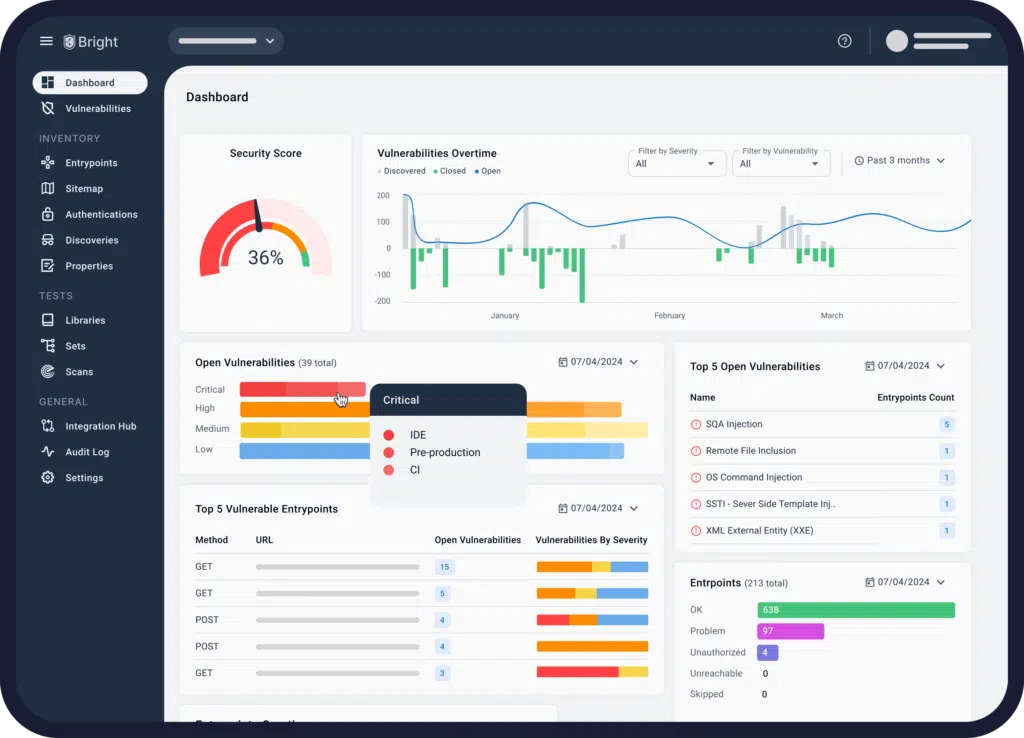DORA (Digital Operational Resilience Act) is the latest addition to the EU regulatory arsenal. A framework designed to bolster the cyber resilience of financial entities operating within the EU. But let’s face it: there’s no lack of regulations issued by the European Union legislature, and they’re not exactly known for keeping things light and easy. The last decade has seen a veritable barrage of highly stringent regulations that had companies worldwide scrambling to implement required sets of measures and avoid pretty hefty fines. The financial sector was no exception. While DORA aims to fortify the financial sector against digital threats, it also presents a formidable challenge for organizations to adapt and comply.
This post delves into what DORA means for your organization’s security posture, explores the intricacies of this regulation, and discusses the processes and tools you can implement to address its requirements. Specifically, why does DAST have such a significant impact on achieving DORA compliance?
What is DORA, and who does it affect?
DORA is a comprehensive regulatory framework that aims to ensure the operational resilience of financial institutions in the face of digital disruptions, such as cyberattacks, IT failures, and natural disasters. It’s not just about preventing these incidents but also about ensuring that organizations recover swiftly and effectively. DORA casts a wide net, affecting a broad spectrum of financial entities operating within the EU, including:
- Credit institutions
- Payment institutions
- Investment firms
- Insurance companies
- Crypto-asset service providers
Essentially, if your organization plays a role in the EU’s financial ecosystem – DORA is knocking on your door, this time not to explore but to regulate.
DORA’s impact on your organization’s security posture
While any new regulation seems like yet another chore imposed by the burgeoning bureaucracy, DORA is actually not just another regulatory checkbox. It’s a paradigm shift in how financial institutions approach operational resilience in more ways than one:
- DORA sets a high bar for security measures, requiring organizations to implement robust cybersecurity controls, conduct regular risk assessments, and establish incident management and reporting procedures.
- The regulation emphasizes the ability to withstand and recover from disruptions. This means having contingency plans, backup systems, and disaster recovery strategies in place.
- DORA extends its reach to third-party service providers, requiring organizations to assess and manage the risks associated with outsourcing critical functions.
- DORA empowers regulators to enforce compliance rigorously, with the potential for hefty fines for non-compliance.
In essence, DORA compels organizations to adopt a proactive and holistic approach to security, ensuring that it’s an integral part of their operational DNA.
Navigating DORA compliance: Processes and tools
Complying with DORA is not a walk in the park. Unless you’re in a seedy part of town, it’s midnight, there’s an all-out gang war, and the park is rumored to be haunted. Then, it might be like a walk in the park. Jokes aside, though, complying with DORA is an achievable goal with the right processes and tools. As with almost any implementation, there’s no one-size-fits-all approach – requirements are comprehensive and diverse, and they will require an in-depth analysis and approach. To help out, we have assembled a series of steps that can assist you in creating your own to-do list:
- Start by conducting a thorough risk assessment to identify vulnerabilities and potential threats to your operations. This will serve as the foundation for your DORA compliance strategy.
- Implement a comprehensive cybersecurity framework that aligns with DORA’s requirements. This includes measures like access controls, encryption, intrusion detection, and incident response protocols.
- Continuous testing is crucial to identify and address security weaknesses before they can be exploited. Employ vulnerability scanning tools and conduct penetration testing to assess your defenses.
- Establish clear procedures for incident management and reporting. This includes defining roles and responsibilities, communication channels, and escalation paths.
- Evaluate the security practices of your third-party service providers and ensure they meet DORA’s standards.
- Educate your employees about DORA’s requirements and the importance of cybersecurity. Regular training sessions can contribute to a security-conscious culture within your organization.
Unleash Bright DAST and accelerate DORA compliance
While the above steps provide a general overview of achieving DORA compliance, leveraging the right tools can significantly streamline the process. Bright Security’s Dynamic Application Security Testing (DAST) solution is one such tool.
Bright DAST is a scanning solution designed to fortify your web applications and APIs against vulnerabilities. By proactively identifying and addressing security risks, Bright DAST empowers you to take swift corrective action, reducing the likelihood of shipping known vulnerabilities to production by an impressive 42%. How does it accomplish that?
- Authenticated scanning – Bright DAST doesn’t just scratch the surface; it dives deep, simulating real-world attack scenarios to uncover hidden vulnerabilities that malicious actors could exploit.
- Business logic vulnerability detection – Bright DAST excels at identifying vulnerabilities in your application’s business logic, ensuring that even the most intricate workflows are secure.
- Seamless integration into the SDLC – Bright DAST integrates into the early stages of your existing software development lifecycle (SDLC), allowing you to catch vulnerabilities sooner in the development process when they are easier and less costly to fix.
When discovering vulnerabilities is a requirement, Bright DAST plays a crucial role in strengthening operational resilience. Financial institutions handle vast amounts of sensitive data and transactions, making them attractive targets for criminals seeking financial gain or aiming to disrupt economic activity. Bright DAST helps mitigate these risks by identifying and helping mitigate security weaknesses, enhancing your ability to withstand and recover from cyberattacks and other disruptions. This is how we achieve it:
- Bright DAST continuously scans your applications, providing real-time visibility into your security posture and enabling you to respond quickly to emerging threats.
- Bright DAST covers a wide range of vulnerabilities, including those listed in the OWASP Top 10, ensuring your applications are protected against the most common and critical security risks.

- Bright DAST provides detailed reports pinpointing vulnerabilities and offering actionable remediation guidance, making it easier for your development teams to address security issues effectively.
Bright DAST not only strengthens your security posture but also streamlines your compliance journey. Aligning with key articles of the DORA framework, such as Article 24 (Operational Resilience Program), Article 25 (Vulnerability Testing and Automated Scans), and Article 33 (Cyber Threat and Vulnerability Information Sharing), Bright DAST enables you to demonstrate your commitment to regulatory requirements effectively. This alignment is further strengthened by:
- Clear Audit Trails – Bright DAST maintains clear audit trails, documenting all scanning activities and remediation efforts, making it easier to demonstrate compliance to regulators.
- Integration with Existing Security Tools – Bright DAST integrates seamlessly with your existing security tools and workflows (e.g., SAST tools like Snyk), minimizing disruption and maximizing efficiency.
- Expert Support – Bright’s security experts can provide guidance and support in implementing our solution.
Moreover, Bright DAST’s impact extends beyond compliance. Financial institutions leveraging Bright’s DAST experience a remarkable 1,000% improvement in vulnerability detection and resolution early in the software development lifecycle (SDLC). This early intervention significantly reduces the risk of vulnerabilities reaching production environments. Additionally, Bright DAST contributes to a 46% improvement in the resolution velocity of production vulnerabilities, ensuring that any issues that arise are addressed swiftly and efficiently.
Bright DAST is more than just a tool; it’s a strategic investment in your organization’s security and resilience. With its verified track record in regulated environments and alignment with industry standards like OWASP Top 10, Bright DAST empowers you to navigate your development cycle confidently. It is built for enterprise-grade scale and security, catering to organizations with high-scale concurrent scanning needs without compromising on security and standards. Features like SSO, RBAC, and audit logs are available on demand, ensuring that your security operations are both robust and efficient.
And just like with Bright, there is an equally important thing to remember about DORA – it is not just about compliance. It’s about building a resilient and secure future for your organization. It may be wrapped in red tape, but then again, so are many genuine gifts. Therefore, gear up, fire up those Bright engines, and let DORA be the catalyst for your stronger security posture.





